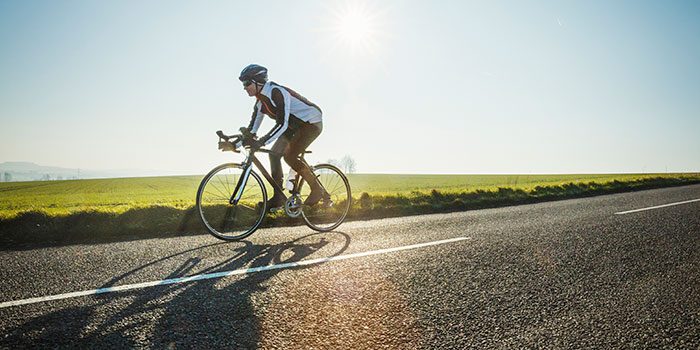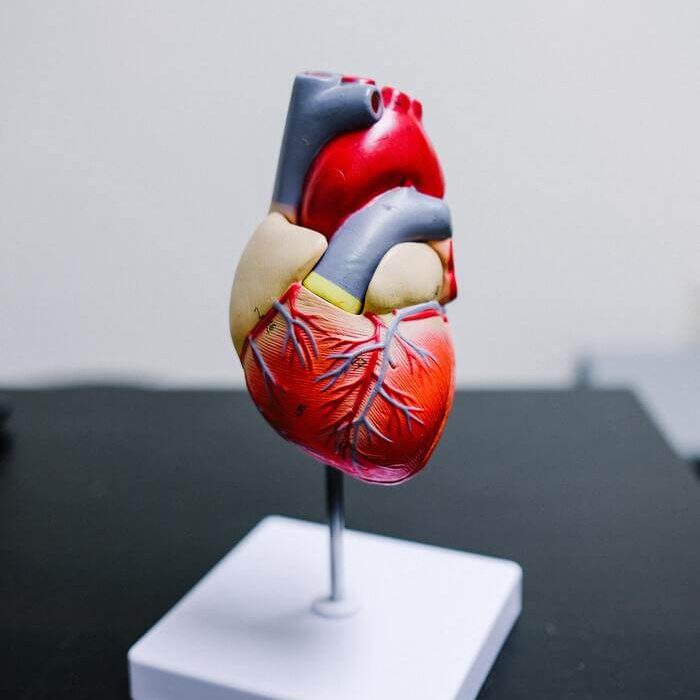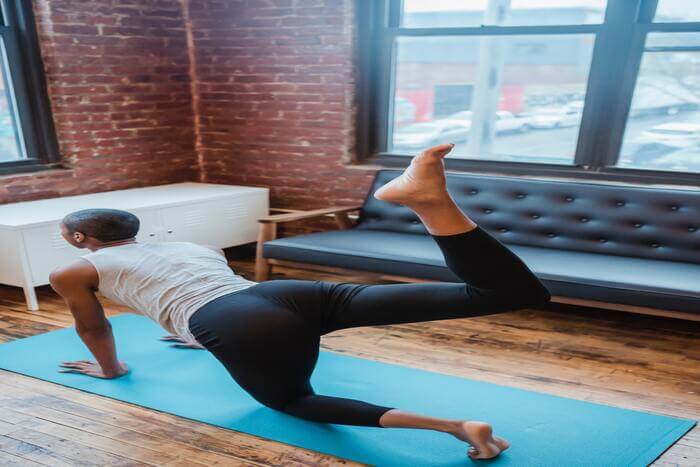
Cycling has long been known as one of the best ways to keep yourself in good physical shape, and its popularity hasn’t been waning in recent years.
More and more people are riding bikes not only to commute, but also to get their daily exercise in — and that’s because they know how beneficial it can be to their overall health and well-being.
Whether you’re a casual cyclist or dedicated road warrior, these eight surprising benefits of cycling will change the way you see your time on the bike. So what are you waiting for?
Table of Contents
1) Reduce Cardiovascular Disease Risk

As we know cycling is a very good form of cardio workout. According to research in The New England Journal of Medicine, those who cycle more than five hours per week have about half as much plaque buildup in their arteries as non-cyclists—good news for people at risk for cardiovascular disease.
Regular cycling also helps to decrease bad cholesterol and triglyceride levels while increasing good cholesterol. When your body uses up its glycogen stores during exercise, you also get an endorphin rush that can elevate your mood and help you relax after a stressful day.
Plus, getting some fresh air could help motivate you to get out and enjoy other physical activities outside of cycling. If you don’t own a bike or feel uncomfortable riding one, there are still plenty of ways to reap these benefits: Join a gym or health club with stationary bikes and classes.
Or if walking is more your speed, try using pedals attached to your shoes! Your walk will provide many of the same benefits as riding without any additional cost or equipment required.
2) Increase Metabolism

Getting out there on your bike and getting some fresh air (and maybe a few much-needed endorphins) is a great way to kickstart your metabolism and give you an energy boost.
In fact, according to physical activity guidelines from The World Health Organization, you should be taking at least 30 minutes of moderate exercise like cycling every day. Exercising regularly helps rev up your metabolism, making it easier for you to burn calories more efficiently.
And if you think being outdoors will negatively impact your weight loss efforts, think again! Recent research shows that exercising in natural environments can actually help reduce stress levels—which have been linked to weight gain in women. So hop on that bike and get pedaling! You’ll soon see why cyclists are among some of healthiest people around.
If increasing your daily calorie burning sounds good to you, then starting with regular cardio workouts may just be what you need. It’s recommended that adults over age 18 get at least 150 minutes of moderate aerobic exercise throughout the week like walking or cycling—the equivalent of about 20 to 60 minutes per day.
But just how effective is cardio? Research published in Frontiers in Psychology found that, on average, cardio workouts led participants to burn about 300 extra calories per session when compared with strength training alone.
More impressive still: When comparing a single session workout vs. multiple sessions per week for six weeks straight, researchers found no difference between average calorie burned between strength training alone or combined with aerobic workouts – so it didn’t take long before those increased calories really started adding up!
3) Protect Vision

Since cycling is an outdoor activity, sunlight can cause vision problems. An optometrist will tell you that over time, UV rays from sunlight can weaken eyesight.
If you cycle regularly, get some good sunglasses and wear them whenever you go on a ride to protect your eyes from harmful UV rays. Exposing your eyes to direct sunlight without protection could also cause eye irritation and even result in temporary or permanent blindness if not taken care of quickly. So, be sure to wear sunglasses as well when you are cycling outside!
This will help ensure safety during your next trip. Don’t forget to carry along an extra pair of glasses too; these might come in handy if you lose yours while cycling! It’s always better to be safe than sorry, right? Protect yourself against potential damage to your eyes with a nice pair of shades.
Just make sure they’re made for cyclists—your normal everyday shades won’t do here! Opt for ones that wrap around your head more completely, have lenses made out of polycarbonate (as opposed to glass), and include UV-protection coating.
Your eyes will thank you later! Also, it’s important to remember that it’s easy to develop cataracts and glaucoma as you age. And one of the best ways to keep both at bay is by getting regular exercise like cycling, which has been shown to lower one’s risk of developing these conditions.
In fact, many doctors recommend regular physical activity like cycling in order to reduce one’s chances of developing cataracts or glaucoma later on in life.
4) Improve Brain Function

Cycling is a great way to get fit, but it’s also a great way to improve your brain function. That might sound strange, but scientists have shown that regular cycling can enhance cognitive performance in older adults, improving things like memory and reasoning skills.
Cyclists who take part in long-distance rides (like more than 100 miles) have even been shown to increase certain regions of their brains—most notably those associated with spatial perception. So put on your helmet and get going! Your brain will thank you for it later.
If you want to start riding or stick with it, here are some tips from UBI Bikes: Get out there . Most people only ride when they have time, which means they don’t make time for it. Put your bike at work so that you can grab it after work or on weekends and go for a quick ride just before dinner.
Or park near an off-leash dog park so you can give Fido some exercise while getting yours in as well. Just get outside and start pedaling every day whenever possible. . Most people only ride when they have time, which means they don’t make time for it.
Put your bike at work so that you can grab it after work or on weekends and go for a quick ride just before dinner. Or park near an off-leash dog park so you can give Fido some exercise while getting yours in as well.
Just get outside and start pedaling every day whenever possible.
5) Help Treat Depression

Not only does exercise help improve mood, but it can also be helpful in treating depression. Researchers think that physical activity helps relieve depression symptoms because it increases neurotransmitters in your brain, including dopamine and serotonin.
One study found that people who took part in high-intensity interval training felt less depressed after a workout session than those who simply walked at a moderate pace. As long as you’re staying active and enjoying yourself, there’s no wrong way to get moving!
If cycling is your go-to mode of exercise, read on for ways to make cycling a little more fun and productive. And if you’re just getting started with an exercise routine, check out these tips to keep going. No matter what your fitness level or goals are, making exercise a priority will have a positive impact on your life.
It will help you live longer and feel better. When used as part of a healthy lifestyle, all types of exercise can also reduce risk factors for heart disease, diabetes and cancer.
Exercise doesn’t have to be hard—it’s good for you whether you’re running marathons or just walking around the block every day. So don’t overthink it: Just do something! It’s easy to start small and build from there when it comes to exercising; even 10 minutes of movement counts!
6) Prevent Osteoporosis

Not only does cycling make your bones stronger, but it can also improve overall body strength. According to a study by The National Institute for Occupational Safety and Health (NIOSH), power cyclists are less likely to experience vertebral fractures and wrist, hip and spine fractures than non-cyclists.
Cycling is an excellent way to prevent osteoporosis and keep yourself strong as you age. In fact, some insurance companies even offer a rebate on premiums if you cycle regularly! Make sure to consult with your physician before beginning any exercise routine.
If you have been sedentary for some time, get medical clearance before starting any physical activity. Once you’re cleared, there’s no reason not to give cycling a try. It’s fun, good for your health and great for weight loss too! Just be sure to dress appropriately—your skin will thank you later.
Wear sunscreen that blocks both UVA and UVB rays along with tight-fitting clothes made from moisture-wicking fabrics like nylon or polyester that help draw sweat away from your skin. This will help prevent chafing, which can lead to infection in addition to being extremely uncomfortable.
Protecting your hands from blisters is just as important—invest in gloves designed specifically for biking or athletic activities so that you don’t lose grip on the handlebars while riding or exercising vigorously.
7) Promote Weight Loss

A lot of people see cycling as a sport rather than a form of exercise and don’t realize how it can help you lose weight.
It’s true, cycling is not going to be your primary way to shed pounds, but when you are doing it for fun and enjoyably, it can make a big difference on your scale at home. With each ride adding up to 590 calories burnt, if you get just an hour in five times a week you will have increased your metabolism by nearly 50% – which means greater weight loss in time.
The whole family can get involved too – so even if they aren’t taking part in their own cycle challenge they can still play their part at home! If you are worried about your health, there are also other benefits that come with regular exercise.
This includes lowering cholesterol levels and reducing stress while increasing self-esteem and confidence. If you want to try something new then why not think about picking up a bike? No matter what type of cycle or riding style suits you best, it could give you a chance to become fitter and healthier in no time at all!
8) Exercise Your Glutes

Cycling is a simple way to get in shape, but it’s also a terrific total-body workout. Plus, cycling is kinder to your joints than other high-impact exercises like running, which makes it a great option for anyone with joint problems.
But did you know that cyclists also benefit from another perk? Because your glutes are among your biggest muscles—and one of your biggest fat-burning zones—cycling can burn major calories in them. Most people don’t even realize they have glutes; if you want to firm up your booty, try adding biking to your routine! (And check out these other ways to work out your butt.)
To exercise your glutes while riding, focus on pedaling hard and fast enough to push yourself back into the seat slightly at the top of each pedal stroke. At first, aim for 30 seconds of vigorous pedaling on each side.
If you find it too difficult or uncomfortable at first, lean forward so that only your toes and forearms rest on your bike frame rather than both feet pressing into the pedals directly.
This will lighten some of your weight and make pedaling more manageable until you feel comfortable extending through your legs again. Remember: Glute engagement matters!
FAQs
what does cycling do for your body
First and foremost, cycling is a low-impact workout that’s easy on your joints. Secondly, pedaling burns tons of calories—about 500 to 1,000 per hour depending on your weight and exertion level. And thirdly, it actually makes you smarter. It improves coordination and stimulates blood flow to your brain while at rest; riding regularly also slows cognitive decline in aging adults (according to research from Columbia University). So what are you waiting for? Put down that Fitbit—and pick up a pair of cycling shoes! Here are eight surprising benefits of cycling: Heading out on a ride can be hard work, but once you’re there it’s usually worth it. You feel strong and fast and ready to take on whatever challenges come your way. But even if you don’t love every minute of biking, some research suggests that hitting the trails could help protect against certain health conditions later in life.
how can you prevent injury while cycling
While all injuries can be serious and debilitating, some are more common than others and can easily be prevented. For example, saddle sores—also known as pressure ulcers or skin breakdown—are a relatively common cycling injury caused by pressure to soft tissue from long hours spent in a bicycle seat. A number of factors contribute to saddle sore development, but one particularly important thing is choosing a saddle that works for you. There are a variety of comfort options that reduce pressure on sensitive areas like sit bones and nerves. While some people find seats with cushioning very comfortable, others prefer firm padding or no padding at all.
what muscles does cycling tone
While cycling is a low-impact workout, it also works your legs, butt and hips. That’s because your hamstrings, glutes and quads work together to pull on pedals while you’re moving forward. These muscles get toned and defined over time. And because cycling tones more than just one muscle group, it can give you a more balanced look over time. Depending on what type of cycle you have (road bike vs mountain bike), you’ll be using different muscles to cycle too — so variation in your workout routine makes sense here too! It’s also important to note that endurance biking burns fat faster than resistance training alone, so why not kill two birds with one stone? Cycling can tone up those biceps while helping you lose weight at the same time!












